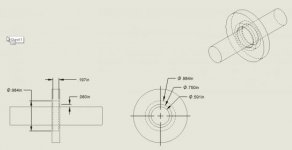commachines
Plastic
- Joined
- May 25, 2016
Follow along with the video below to see how to install our site as a web app on your home screen.
Note: This feature may not be available in some browsers.
I need to make a 0.984"(25mm) O ring groove in a part with a 0.610" ID bore (on a lathe). So far I haven't been able to find any ID grooving tools that can make a 0.187" per side groove in such a small ID bore. any suggestions?View attachment 321299
An o-ring you say? It'd have to be a -312, and without seeing the mating parts I'm very suspicious of this component functioning as a seal. Do you have any input to the design? I'd wager that you'll see better performance with a -208 and an appropriately shallower groove, but without seeing the rest of the system I can't say for sure.

I need to make a 0.984"(25mm) O ring groove in a part with a 0.610" ID bore (on a lathe). So far I haven't been able to find any ID grooving tools that can make a 0.187" per side groove in such a small ID bore. any suggestions?View attachment 321299

Here's what I came up with:
an AS568-208 standard size is a much more sensible cross section than that fatboi specified by your engineer. They can be had from McMaster in packs of 5 for nearly the same price as single o-rings of that other size. If you are stuck with the other o-ring I mathed out grooves for both. Looks like low pressure so the clearance to your tube is non-critical. I assumed your tube is 15±0.1mm for the calculations.
View attachment 321343
You need more width, both in the groove itself and the walls. I wouldn't be surprised if installation of the fatty blew out those paper thin delrin walls without even considering installation force. If you are width limited then you can cheat a little on the groove and/or walls, but almost certainly need to decrease the o-ring CS in that case.

thanks again for the help...
My engineer is stuck on using the fat O ring as apparently it is more forgiving for any intolerances and will last longer etc...
Since it is a low pressure application, he is suggesting that we make the bore size larger to allow me to use a standard ID grooving tool and avoid the wall blowout in installation. I am limited by space so cannot make the delrin disk any thicker so am stuck with the 0.027" walls... Can you see this working or are we stupid to not go down to a thinner wall O ring as you suggested?
see new dimensions.
View attachment 321416
 ). The o-ring is slightly larger OD (.887") than the .837 groove, so it will pre-set into place well enough to get it on the shaft without the forward-facing wall.
). The o-ring is slightly larger OD (.887") than the .837 groove, so it will pre-set into place well enough to get it on the shaft without the forward-facing wall.Notice
This website or its third-party tools process personal data (e.g. browsing data or IP addresses) and use cookies or other identifiers, which are necessary for its functioning and required to achieve the purposes illustrated in the cookie policy. To learn more, please refer to the cookie policy. In case of sale of your personal information, you may opt out by sending us an email via our Contact Us page. To find out more about the categories of personal information collected and the purposes for which such information will be used, please refer to our privacy policy. You accept the use of cookies or other identifiers by closing or dismissing this notice, by scrolling this page, by clicking a link or button or by continuing to browse otherwise.
